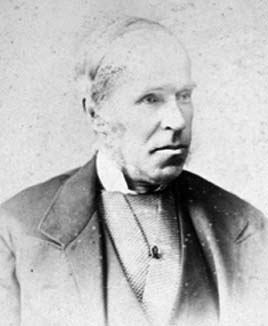


 تاريخ الرياضيات
تاريخ الرياضيات
 الرياضيات في الحضارات المختلفة
الرياضيات في الحضارات المختلفة 
 الرياضيات المتقطعة
الرياضيات المتقطعة
 الجبر
الجبر
 الهندسة
الهندسة 
 المعادلات التفاضلية و التكاملية
المعادلات التفاضلية و التكاملية 
 التحليل
التحليل
 علماء الرياضيات
علماء الرياضيات |
Read More
Date: 13-11-2016
Date: 12-11-2016
Date: 13-11-2016
|
Died: 3 January 1891 in Dublin, Ireland

John Casey, mathematician and teacher, was born 12 May 1820, in the townland of Coolattin, in the parish of Kilbehenny, Co. Limerick. Tradition has it that he was orphaned at the age of nine and raised by neighbours. He became a teacher under the Board of National Education at a school in Tipperary Town and was then appointed headmaster of the newly-opened Kilkenny District Model School in 1854. While resident in Kilkenny, Casey was introduced to advanced mathematics by a former student of Trinity College, Dublin, who proposed that Casey should study a theorem of Poncelet, concerning polygons inscribed in a circle of a coaxial system. Casey's short proof of Poncelet's theorem was communicated to Richard Townsend, Fellow of Trinity College, in 1858, and was published in the Quarterly Journal of Mathematics 5 (1862), 43-53. Casey thereafter corresponded with Townsend and George Salmon on geometric problems, and they persuaded him to enter Trinity College as pensioner in 1858 to undertake a degree course; he was elected a non-foundation scholar in 1861 and graduated in 1862. In early 1862, he became Science Master at Kingstown Schools (Dun Laoghaire). He published several research papers on geometry while studying for his degree, and the influence of the group of geometers working at Trinity College, including W R Hamilton, A S Hart, Salmon and Townsend, is apparent in this work. He also served as an editor of the journal Messenger of Mathematics between 1862 and 1868.
Casey applied unsuccessfully in 1867 for the vacant professorship of mathematics at Queen's College, Cork. As there were several well qualified candidates, his failure to be selected cannot be considered unfair, contrary to the opinion of an earlier obituarist. In 1873, he was offered the position of professor of mathematics at the Catholic University in Dunlin. A little later, he was offered a specially created professorship in geometry at Trinity College. In a letter to Townsend dated 5 November 1873, he declined this position, and Townsend explained in a letter to the Registrar of Trinity College, written the following day, that Casey felt obliged to accept the professorship at the Catholic University. As the Catholic University had virtually no students and could not pay regular salaries, Casey supported himself by giving grinds. Between 1873 and 1882, he prepared students at the French College, Blackrock, for the Civil Service entrance examination, and he was employed as a professor of mathematics at the Civil Service College, opened as a department of the French College in 1875. Following the establishment of the Royal University in 1880 and the reconstitution of the Catholic University premises at St Stephen's Green as University College, Casey was elected to a fellowship of the Royal University in 1882, at a yearly salary of £400.
Casey wrote over 25 research papers but his mathematical reputation rests on the six textbooks he wrote: A sequel to the first six books of the Elements of Euclid (1881; 8th ed. 1910); A treatise on the analytical geometry of the point, line, circle and conic sections (1885; 2nd ed. 1893); A treatise on elementary trigonometry (1886); A treatise on plane trigonometry (1888); A treatise on spherical trigonometry (1889). He also published his own edition of The first six books of the Elements of Euclid (1882; 17th ed. 1902) which is remarkable for its large store of exercises, collected and devised by himself and Richard Townsend, which occasioned the publication of a separate Key to the exercises of Casey's Elements of Euclid (1885) by Casey's son, Joseph. It was in his Sequel to Euclid that Casey presented for the first time in a textbook those extensions of the theorems of Euclid that became known as the newer geometry of the triangle; indeed, he and the French mathematician Émile Lemoine (1840-1912) are held to be the founders of the so-called Modern Geometry of the circle and triangle. Casey's work was much appreciated in Belgium and France, and Professor Joseph Neuberg of Liège made substantial additions to later editions ofSequel to Euclid.
Casey married Catherine Ryan in 1847; they had four children, two boys and two girls. From 1875, the family lived at 86 South Circular Road, Dublin. Casey's daughter Catherine married Patrick Dowling, later Registrar of the Royal College of Science in Dublin, who edited revisions of some of Casey's textbooks. Casey was a member of the Royal Irish Academy (1866) and fellow of the Royal Society (1875), and held honorary doctorates in laws from Trinity College Dublin (1869) and the Royal University of Ireland (1885). He maintained a lifelong love of the Irish language, which he had learned in childhood, and was a member of the Gaelic Union and the Society for the Preservation of the Irish Language.
From 1874 or 1875 onwards, Casey lived at 86 Iona Terrace, which is part of the South Circular Road in Dublin and close to Casey's place of work at St Stephen's Green. Casey died of bronchitis on 3 January 1891 and was buried at Glasnevin Cemetery.
Articles:



|
|
|
|
لصحة القلب والأمعاء.. 8 أطعمة لا غنى عنها
|
|
|
|
|
|
|
حل سحري لخلايا البيروفسكايت الشمسية.. يرفع كفاءتها إلى 26%
|
|
|
|
|
|
|
جامعة الكفيل تحتفي بذكرى ولادة الإمام محمد الجواد (عليه السلام)
|
|
|